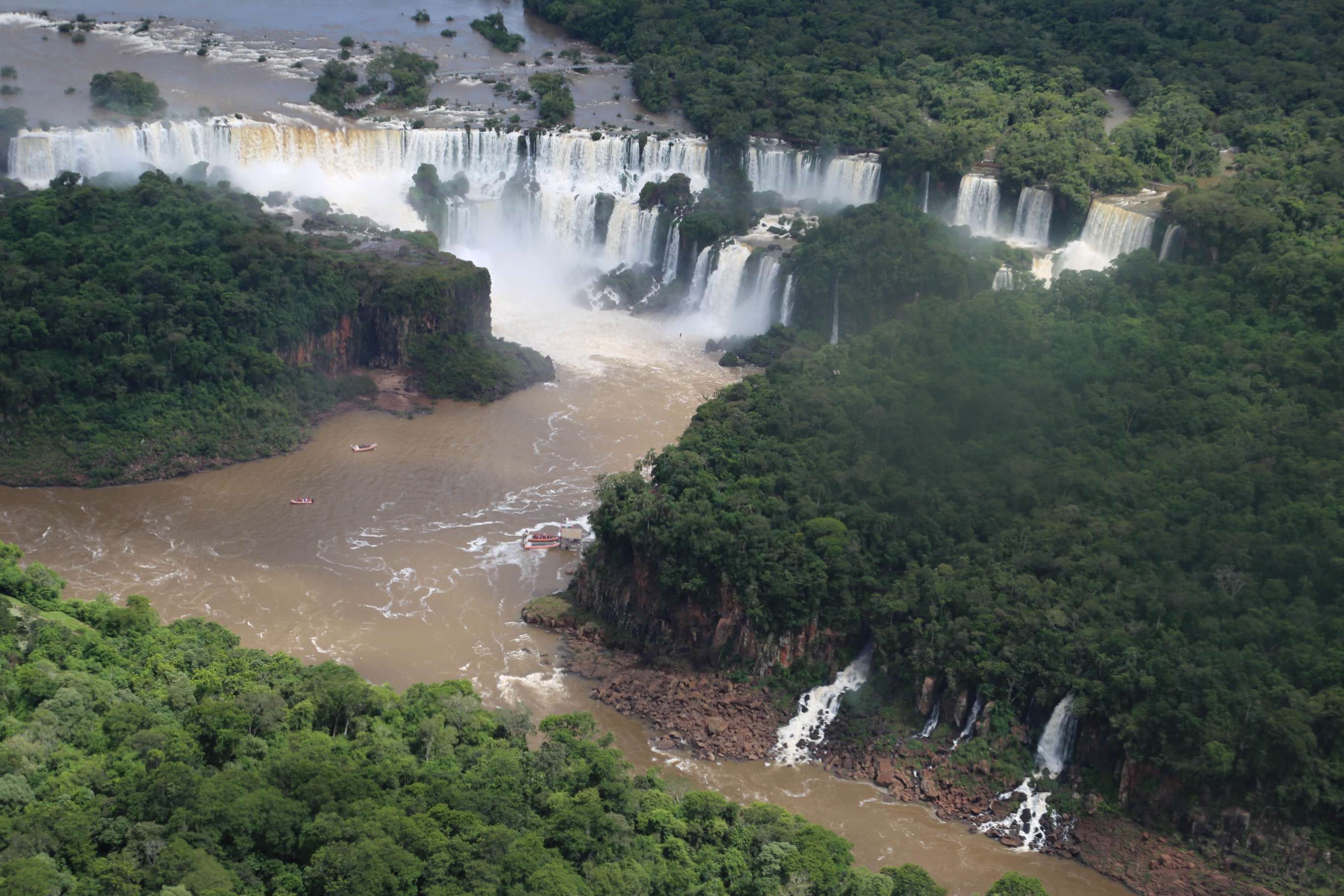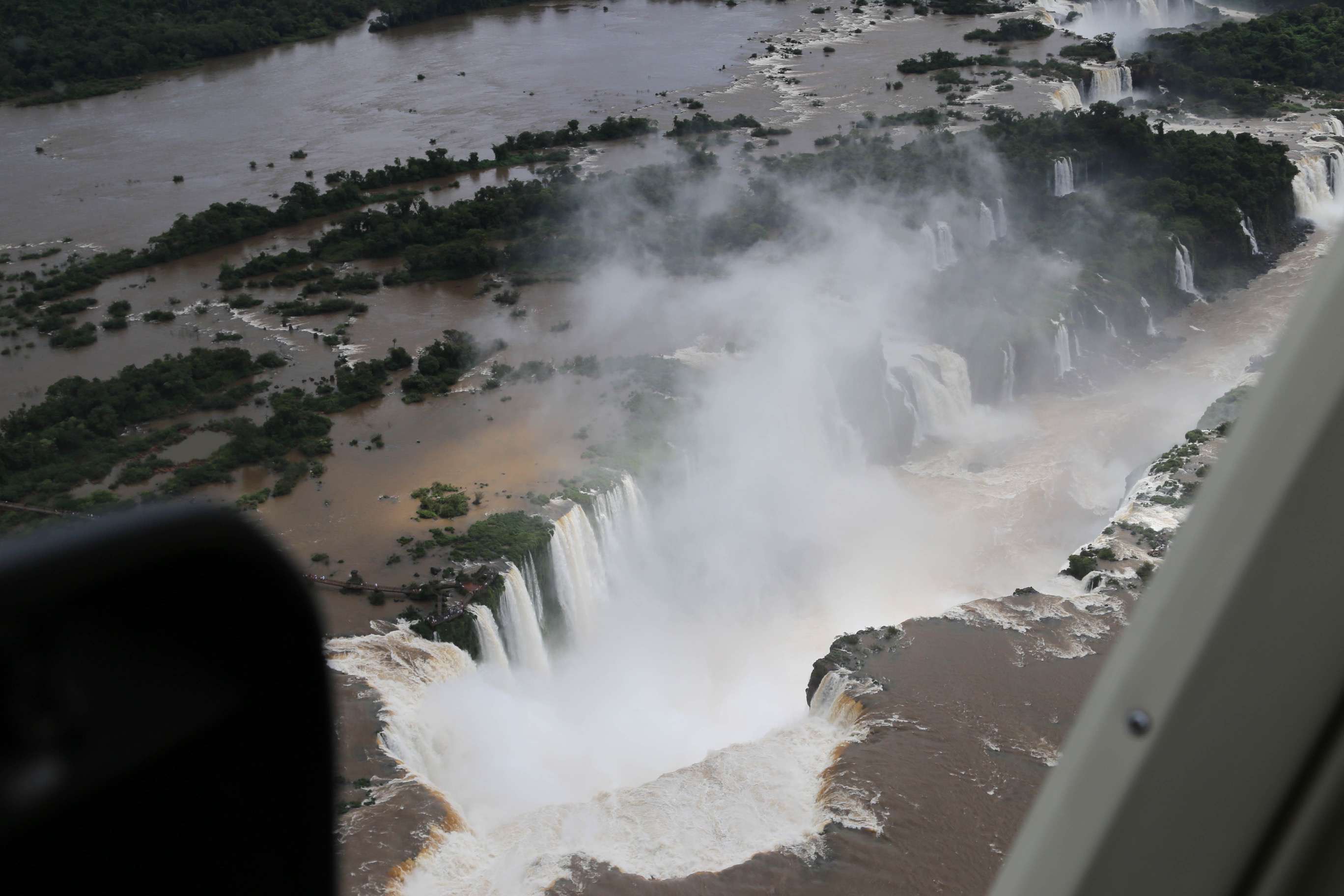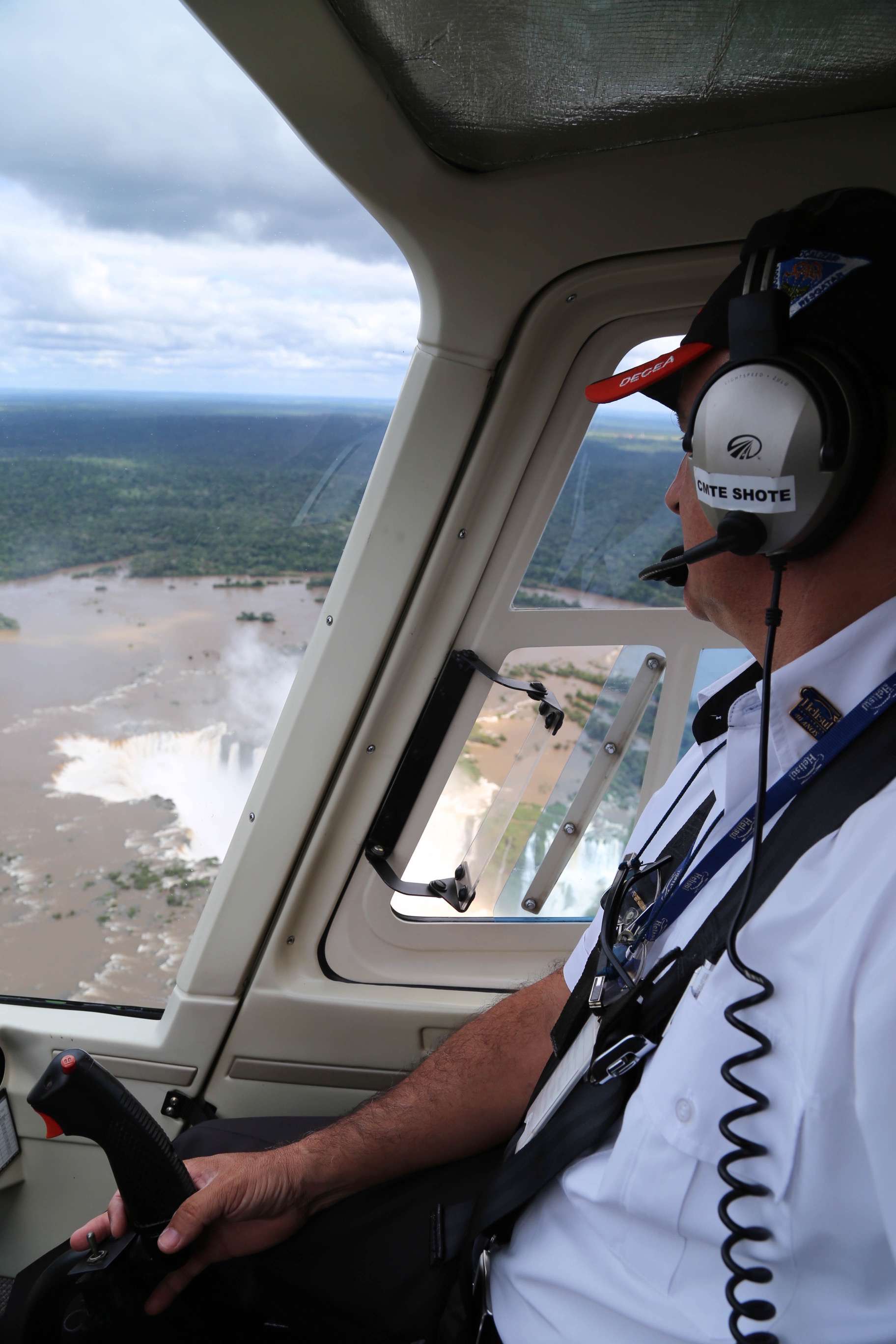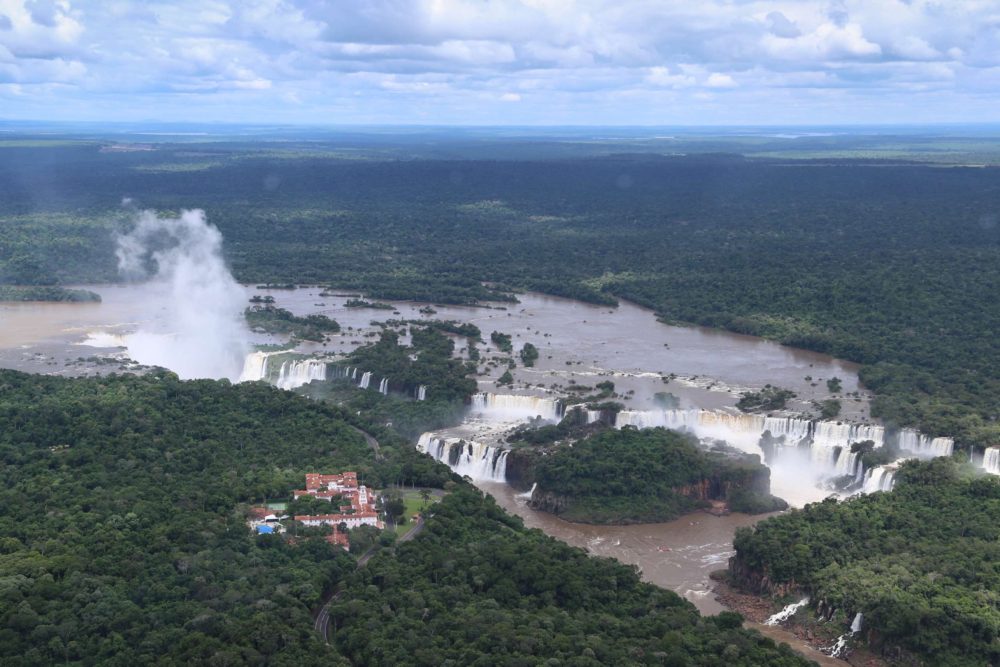
Iguazu Falls dwarfs everything around it, including the posh hotel in the foreground, on the Brazilian side of the falls.

What appears to be smoke is actually mist that can be seen from miles away, churned up as water cascades down Devil’s Throat at Iguazu Falls.
When laws of nature cross paths with a happenstance of geology, in this case water, gravity, and topography, a waterfall results. The basic configuration is the same, but every waterfall is distinctive and beautiful in its own way. By many definitions, one of the most impressive and incredible waterfalls on the planet is Iguazu Falls, proudly claimed by both Argentina and Brazil.

From the vantage point of a helicopter some of the hundreds of waterfalls that comprise Iguazu Falls are revealed.

Devil’s Throat dumps a massive volume of water creating a giant plume of mist from a helicopter view.

Tons of water are frozen in time as it plunges over the edge of the falls and a continual plume of mist waxes and wanes from Devil’s Throat.

Claiming to have one of the best “office” views on the planet, licensed photographers do a steady business snapping photos for tourists at this observation point at Devil’s Throat on the Argentine side of Iguazu Falls.
A number of features make Iguazu Falls special. Probably the most breathtaking aspect is the portion known as the Devil’s Throat, a U-shaped formation at the beginning of the head of the falls approximately 490 feet wide and 2,300 feet in length. The amount of water and the overall drop means there is a perpetual cloud of mist, often rising above the level of the Iguazu River. The overall length of Iguazu Falls is another distinctive element, and with approximately 1.6 miles of length, Iguazu is more than a half-mile longer than Victoria Falls (1.06 miles), and more than twice the length of Niagara Falls.

The walkways built out over the water on both the Brazilian and Argentinian sides of Iguazu Falls give tourists plenty of places to behold the beauty and power of the falls, as the writer, center, takes another picture. (Photo by Kay Kardos)

Visitors linger to look and take photos at one of the observation spots on the Brazilian side of Iguazu Falls.

No visit to the Brazilian side of Iguazu Falls would be complete without venturing out onto the walkway where mist from the falling water creates a perpetual rain that drenches everyone and everything.

It takes considerable engineering and construction skill to build walkways out over the water, but the views are well worth the effort.

At this spot on the Brazilian side of Iguazu Falls about all you can hear is the thunderous roar of water and squeals of delight..
Iguazu Falls is actually hundreds of waterfalls, with estimates of as many as 275 individual falls, depending on flow rate. The size of the falls range from the gargantuan Devil’s Throat to smaller falls that peek out from the forest and course between rocks.

Sunlight filtered through the clouds above give the falls a dappled look as the water flows endlessly.

Venturing along with walkways, visitors can glimpse beautiful flowers.

Iguazu Falls is a haven for butterflies, found in many places, sometimes fluttering perilously close to the waterfalls.

Butterflies will often land on people, presumably to take some salt from their skin.

Motor boats with powerful engines take visitors up close to the base of the falls.
Sure, other waterfalls have a greater mean flow rate, including Niagara Falls on the U.S. and Canadian border (number five), Boyoma (nee Stanley) Falls in Africa, and Khone Phapheng Falls in Laos (number two). But none of those has the overall drop of Iguazu Falls, at nearly 270 feet. And while Victoria Falls, on the Zimbabwe and Zambia border has a greater drop than Iguazu Falls, at more than 354 feet, it has a much smaller mean flow rate at 287,419 gallons per second compared to Iguazu Falls 461,244 gallons per second – an Olympic-sized swimming pool would be emptied in less than a second and a half (ranking Iguazu Falls sixth in mean flow rate). Boyoma Falls, by comparison, has the largest mean flow rate in the world, dumping a mind-boggling 4.5 million gallons of water over the edge every second.

Captain Silvio Choate may be one of the most frequent visitors to Iguazu Falls, ferrying four passengers at a time to savor breathtaking views.
Perhaps with the exception of Niagara Falls (which receives upwards of 20 million visitors annually), Iguazu Falls is one of the more developed of the world’s great waterfalls. There are miles and miles of trails and walkways on both the Brazilian and Argentine sides of the falls. A number of walkways enable visitors to venture toward the center of the Iguazu River to marvel at the cascading water. And on the Argentine side, a walkway goes to the edge of the Devil’s Throat where visitors can experience the thundering power of nature. But even with all the walkways that afford visitors a close-up view, Iguazu Falls only receives approximately 750,000 people each year, due in large part to its isolated location.

From almost any angle, Iguazu Falls is a sight to behold.

Some of the waterfalls seem to wander, while others thunder, with a combined effect that is incredible.

The walkway at the lower left, on the Argentine side, gives visitors up-close views and a sense of isolation.

Protected by a rainbow, another group of tourists is about to get an up-close view of the base of the falls.
An exciting introduction to Iguazu Falls is the helicopter ride from the Brazilian side (Argentina prohibits such activity). The short flight creates an unforgettable visual impact for passengers to see the overall layout and majesty of the falls.

Even some of the smaller examples at Iguazu Falls would be considered large water features elsewhere.

The sheer size and volume of water going over the falls is just part of what makes Iguazu Falls spectacular.
Not surprisingly, Iguazu Falls is a UNESCO World Heritage Site, designated in 1984. As far back as 1934 Argentina declared the area a national park. In 1541 the first European to set sight on Iguazu Falls was Spanish conquistador Álvar Núñez Cabeza de Vaca. The name Iguazu comes from indigenous people living there who name it y (water), uasu (big). The beauty of the location has made it a popular backdrop for more than 20 movies and television shows, including Moonraker, The Mission, Indiana Jones and the Kingdom of the Crystal Skull, Captain America: Civil War, and episodes of Miami Vice among other productions.

The Iguazu River moves along at a lazy pace just before it plunges down the rift face and boils up an ever-present mist.

Iguazu Falls is a grand partnership of nature — jungle, waterfalls and sky.
Iguazu Falls is a place of grandeur, a spot where Mother Nature has crafted one of the earth’s great treasures – a magical wonder of sight, sound and majesty.

Even a small amount of time spent at Iguazu Falls allows one to bear witness to the magnificence of one of nature’s grand spectacles.
For more information about Iguazu Falls, click over to these website:
